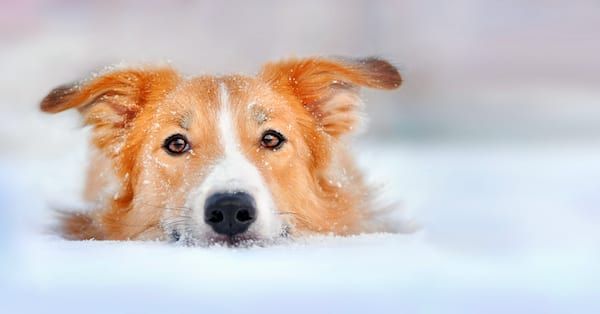
How To Spot Hypothermia In Dogs & Cats
The winter months are great time for playing with your pets in the snow, but too much exposure to the elements can lead to hypothermia in dogs & cats. If your dog or cat goes “hypothermic,” there are actions that MUST be taken fast to get them back to a healthy core temperature. This short article explains the condition of hypothermia, how to spot the signs of hypothermia in dogs and cats, typical home treatments, and veterinary treatments for more severe cases. Of note, hypothermia and frostbite are related, but separate medical conditions.
What Is Hypothermia in Dogs & Cats?
 Hypothermia in dogs & cats is a condition that occurs when your pet’s body temperature drops to dangerous levels. It’s also important to know that hypothermia can occur when your pet is outside, when they’re inside a structure (pets left in an unheated garage or barn), and pets exposed to cold or wet inside a house for extended periods of time.
Hypothermia in dogs & cats is a condition that occurs when your pet’s body temperature drops to dangerous levels. It’s also important to know that hypothermia can occur when your pet is outside, when they’re inside a structure (pets left in an unheated garage or barn), and pets exposed to cold or wet inside a house for extended periods of time.
What’s a Normal Body Temperature for a Dog or Cat?
- A normal body temperature for a dog is 100.0 to 102.5 degrees Fahrenheit.
- A normal body temperature for a cat is 100.0 to 103.0 degrees Fahrenheit.
What are the Levels of Hypothermia in Dogs & Cats?
Hypothermia in dogs & cats can occur with different levels of severity. But there are 3 main classifications:
- Mild Hypothermia (Body temperature of 95-99 degrees Fahrenheit)
- Moderate Hypothermia (Body temperature of 86-95 degrees Fahrenheit)
- Severe Hypothermia (Body temperature less than 86 degrees)
What Happens When a Pet Gets Hypothermia?
When your pet’s body can’t maintain a normal body temperature, the following will typically occur:
- Central Nervous System Shutdown: Your pet’s central nervous system will start to shut down. The central nervous system is responsible for vital functions like maintaining breathing, pumping blood, and brain activity.
- Cardiovascular System Shutdown: Heart activity and blood flow will slow or shut down, and arrhythmias may develop.
- Respiratory Shutdown: Breathing will significantly slow or shut down.
- Immune System Shutdown: Your pet’s immune system will start to shut down as well.
NONE of this is conducive to maintaining a healthy pet. For example, think of a situation where you were exposed to bitter cold for a lengthy period of time, how miserable you felt, and how being cold for so long sucked all your energy. The same can happen to your pets.
What are the Signs of Hypothermia in Dogs & Cats?
There are many signs that your pet has some degree of hypothermia. Here are some typical signs that your pet’s core temperature has dropped to dangerous levels:
Signs of MILD Hypothermia
- Shivering
- Lack of mental alertness
- Weakness
Signs of MODERATE Hypothermia
- Slow, shallow breathing
- Stiffness in muscles
- Being a stupor
Signs of SEVERE Hypothermia
- Difficulty breathing
- Dilated, fixed pupils
- Faint heartbeat
- Coma
What Pets Are Most At Risk for Hypothermia?
Here’s a look at the pets most at risk for hypothermia:
- Newborn puppies & kittens
- Small breed dogs
- Pets with minimal fur, or short hair, or matted fur
- Senior dogs & cats
- Sick pets
- Pets that have just been under anesthesia
- Pets with low body fat
What are the Treatments for Hypothermia in Dogs & Cats?
Treatments for hypothermia vary, depending the severity of the hypothermia…but common sense prevails. Your number one priority is to get your pet warm and dry, and to keep treating them until they reach a normal body temperature. Also keep in mind that, as you initiate the warming process, your pet’s body temperature may drop even more as the warmer blood at the core comes into contact from the blood at the skin’s surface.
Here are typical treatments for dogs or cats with hypothermia:
MILD Hypothermia Treatment:
- This is more a passive process of encasing your pet with insulation so their body temperature can increase of its own accord.
- Minimize movement to prevent further heat loss while your pet is being warmed up.
- Wrap your pet with thermal insulation and warm blankets.
MODERATE Hypothermia Treatment:
- This is a more active process of re-warming your pet.
- Wrap them with blankets to get them warm and dry.
- In addition to wrapping them in blankets, you can apply an external heat source such as heating pads applied to your pet’s abdomen to start warming the core.
- When you apply an active heat source, put a protective layer of fabric or towel between your pet’s skin and the heat source in order to avoid burns.
SEVERE Hypothermia Treatment:
- Start the warming process by wrapping your pet in blankets.
- Take your pet to your veterinarian immediately for application of warmed intravenous fluids and monitoring of body temperature and blood pressure.
- At this very dangerous stage, your pet may also need oxygen which will be administered using a face mask.
- Your pet also will be examined and possibly treated for frostbite.
How Do Pets Typically Get Hypothermia?
Here’s a look at how pets can get hypothermia:
- Being left outside too long in the rain, sleet, snow, and cold.
- Lack of shelter and a warm dry surface on which to lie (for pets left outside)
- Lack of a warm, dry surface on which to lie (when left in a garage or barn on bitter cold nights)
- Pets that fall into ponds, creeks, or streams, or simply get soaked through
How to Prevent Hypothermia in Dogs & Cats
 Limit Outside Time in Rain, Sleet, Snow & Cold: Limit the amount of time pets spend outside and observe for signs of hypothermia. Bring pets in and warm them up and dry them at any signs of hypothermia.
Limit Outside Time in Rain, Sleet, Snow & Cold: Limit the amount of time pets spend outside and observe for signs of hypothermia. Bring pets in and warm them up and dry them at any signs of hypothermia.- Limit Access to Ponds, Streams, Creeks & Puddles: When your pets get wet, their fur no longer insulates them. Keep them dry!
- Outside Pet Shelter with a Raised Floor Is a Must: If your pets are kept outside in the winter, they must have shelter in the form of an insulated dog house with a raised floor where they are not lying on frozen, wet dirt or snow/ice, and which provides shelter from the wind. They also will stay warmer if they have a blanket upon which to lie.
- Garage Pet Shelter with a Raised Floor: There are plenty of stories of dogs and cats that have frozen to death inside a garage. If your pet has to sleep in the garage, it’s wise to provide a sheltered area with a raised floor and blanket so they are not losing body heat from sleeping on ice cold cement.
- Proper Grooming: For dogs in particular, a regimen of regular grooming can help keep your pet warm. If their fur is matted, it loses its insulation properties. Groom your pets regularly to keep their fur fluffed. For double-coated dogs, don’t remove the soft under layer of fur. That provides vital insulation. Just keep to a schedule of regular brushing to make sure the downy under layer of fur doesn’t get matted.
- Adjust Food Portions Upward: It takes energy to stay warm. If you find that your dog or cat becomes underweight during the winter, increase their rations to help them maintain body fat.
- Bring Pets Inside on Bitter Cold Nights (and Days): One of the simplest ways to prevent hypothermia and frostbite is to monitor outdoor temperatures and bring your pets inside when it’s cold.
Winter weather in Colorado is a given. Hypothermia in dogs and cats is not, and is preventable with these simple steps.
If you think your pet has hypothermia or is showing any of the symptoms mentioned above, especially in the Moderate or Severe category, contact Sky Canyon Veterinary Hospital immediately, and make arrangements to get your pet emergency treatment. For hypothermia or other emergencies, call us at: 970.985.4911, or visit the Emergency page on our website: www.SkyCanyonVeterinaryHospital.com.
